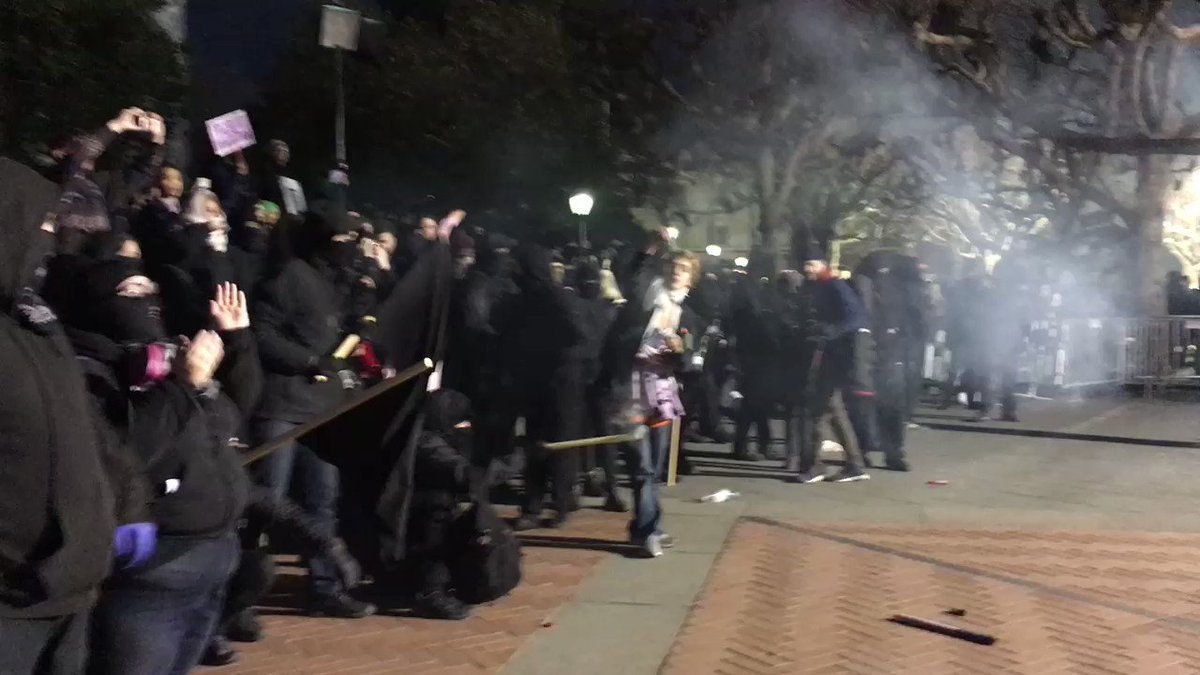The Black Bloc keeps growing
Swarms of people dressed in black invaded what was supposed to be a peaceful demonstration against right-wing commentator Milo Yiannopoulous on Wednesday evening.
The group tossed smoke bombs, set fires and started fights on the University of California - Berkeley campus where Yiannopoulous was slated to speak. He never would.
The protest's organizers, the Berkeley Against Trump coalition, said the peaceful acts of the 1,500 demonstrators were marred by 50 to 75 anti-fascist Black Bloc protestors.
Outside of Berkeley, media outlets have linked Black Blocs to a number of modern protests, most recently in efforts opposing President Donald Trump . The Nation credits a Black Bloc protestor with punching alt-right leader Richard Spencer in the face on Trump's inauguration day. The Washington Post said Black Blocs were involved with violent protests in Washington, D.C . on inauguration day and in Portland following Trump's election win.
On Wednesday, Twitter users used the term in describing the protesters at Berkeley.
Black Bloc, is a tactic, not a group. Those who practice it often wear black and cover their face with masks. They usually leave a wake of destruction.
In a 2015 article published in Police Magazine, author Kory Flowers said anarchists use protests such as the ones in Ferguson, Missouri , after the shooting death of Michael Brown, to launch their signature "chaos- and havoc-laden tactics." The article described Black Bloc strategy as "throngs of criminal anarchists all dress in black clothing in an effort to appear as a unified assemblage, giving the appearance of solidarity for the particular cause at hand."
Black Bloc gained attention in the United States in 1999 after violent protests at a meeting of the World Trade Organization in Seattle, according to a 2001 history of the tactic on the anarchist news website, A-Infos. The reason for the dress, wrote the history's author Daniel Dylan Young , was to "fend off police attacks, without being singled out as individuals for arrest and harassment later on."
Hundreds of people were arrested in the Seattle riots, which involved anarchists vandalizing businesses.
Young said Black Blocs spread in Europe in the 1980s as a "popular resistance to the police state and the New World Order." About 3,000 people engaged in a Black Bloc protest in 1987, according to A-Infos, when President Ronald Reagan visited Berlin.
"We didn't anticipate the violence," she said, adding she was disappointed that "the media attention has been skewed so heavily toward that."
However, the group is happy Yiannopoulous' speech was cancelled, which was the coalition's goal. West said the group, formed in the fall semester, gathered support for the Yiannopoulous protest during an inauguration day demonstration. For weeks, West said, the group urged the school's administration to cancel the event.
In a statement, UC Berkeley Chancellor Nicholas Dirks condemned the violence, which he said was committed by more than 100 armed people using paramilitary tactics. Campus administration pulled in dozens of extra police officers to help control the event, but weren't prepared for the "unprecedented," he said.
Dirks assured the campus is committed to free speech.
"We deeply regret that the violence unleashed by this group undermined the First Amendment rights of the speaker as well as those who came to lawfully assemble and protest his presence," the statement read.
But West slammed Dirks for denouncing the violence, something she said he could have avoided.
"It's extremely frustrating that he's condemning the violence when he had every opportunity to cancel the event and stop this from happening," she said.
The Black Bloc keeps growing
 Reviewed by Unknown
on
5:02 AM
Rating:
Reviewed by Unknown
on
5:02 AM
Rating:
 Reviewed by Unknown
on
5:02 AM
Rating:
Reviewed by Unknown
on
5:02 AM
Rating:













No comments: